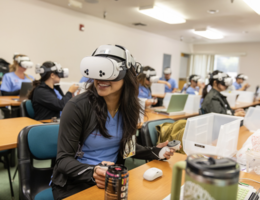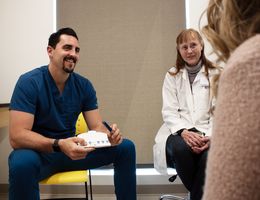

LLU alumna Fayette Nguyen Truax is reducing health disparities experienced by vulnerable immigrant populations (Photo by Chet Williams)
Originally appeared in Fall 2022 edition of Scope
What does it take to squash a centuries-old infection driven by health disparities among a growing community of millions? Fayette Nguyen Truax, PhD, RN, CPNP-PC is reaching for the answer through her research and interventions designed to educate, test, and treat those most at risk of developing tuberculosis among Orange County communities: immigrants from Southeast Asian countries.
A respiratory disease, tuberculosis (TB) usually affects the lungs but can also affect the brain, the kidneys, or the spine. Left untreated, TB can be deadly. People who inhale air containing TB germs can become infected with a latent TB infection (LTBI), a dormant state of TB that places them at higher risk of developing active TB in the future.
Efficient screening, testing, and treatment of LTBI via oral medications coupled with culturally-sensitive TB education can stop the spread of TB, according to research by Nguyen Truax. However, to reduce TB cases in Orange County, treatment of LTBI in high-risk Orange County residents with chronic diseases is the first step, since this population has a greater chance of LTBI reactivation. Nguyen Truax frequently encounters misinformation or lack of education about TB and LTBI in the community that filters into medication non-compliance among the highest risk groups.
I want to help these immigrants as someone who speaks the language, shares a similar background, and grew up in the same community.
The groups that are most at risk for LTBI reactivation are immigrants from Asian countries who have been living in the United States for five years, are over 50 years old, and have comorbidities. Often, unsuspecting immigrants with LTBI with no symptoms move to the U.S. and don’t seek treatment, “spreading the infection to others when their LTBI awakens,” says Nguyen Truax. Last year, two-thirds of all active TB cases in Orange County occurred among Asians, according to county health reports.
“I want these people to live happy, healthy lives with their families in the community,” Nguyen Truax says. “If they don’t accept treatment for latent tuberculosis and the disease becomes active, not only does it jeopardize longevity by increasing the risk of death in elderly people, it also affects their children, their family, and the whole community they love so much as the disease spreads to other vulnerable people.”
Among the highest risk tuberculosis populations of immigrants from Asian countries, the top countries of origin include the Philippines, India, and Vietnam. The latter of the list, in particular, piqued Nguyen Truax’s curiosity. “Vietnam is a small country, and there are many other Asian countries in close proximity to it. So why Vietnamese people?” she questioned.
She began to dig into the research of tuberculosis in this particular migrant population— but studies proved sparse and dated.
“I thought, ‘why hasn’t anyone looked into this particular Asian Vietnamese group?’ I want to be the researcher for this group,” she says. “I want to help these immigrants as someone who speaks the language, shares a similar background, and grew up in the same community.”
At age three, Nguyen Truax became one of roughly 700,000 “boat people,” refugees who fled Vietnam by boat following the collapse of the South Vietnamese government. She settled with her parents and six siblings in Orange County. Upon arrival, the family underwent testing and treatment for LTBI at the same county health department that Nguyen Truax has been working with for the past decade.
But her family’s completion of LTBI treatment was an exceptional one. The majority of Vietnamese immigrants do not get tested for LTBI, Nguyen Truax says. Even if immigrants do get tested, Nguyen Truax says they likely won’t accept, initiate, or complete treatment due to the stigma surrounding medications used to treat LTBI.
For instance, Vietnamese culture categorizes medicines into “cold” and “hot,” Nguyen Truax explains; herbal medications are considered "cold," while other medicines such as painkillers or antibiotics are “hot,” inflammatory, and harmful to the body. In addition, the standard regimen for treating LTBI consists of a daily dose of antibiotics for six to nine months — an extra-long time for someone to commit to taking medications they don’t trust, Nguyen Truax points out.
“These elderly immigrants are often misguided with information from Vietnam and how they grew up there,” she says. “It's not that they are stubborn. It's that they don't have the right education or avenues to access the right information.”
Now, Nguyen Truax works with both Orange County TB services and community clinics in the region to raise awareness in the Vietnamese community about TB and LTBI. She has created a video starring Vietnamese actors speaking Vietnamese to directly address culture-specific myths about LTBI and medications. She designed the script to convince Vietnamese viewers who are skeptical about LTBI treatment to accept and engage in the treatment process. The video myth-busts commonly held, misguided beliefs about medications from Vietnamese culture, offers facts about health consequences, and stresses the importance of accepting treatment.
“There were no tuberculosis-focused educational videos specific to Vietnamese people, or even Asians,” Nguyen Truax says. “I wanted Vietnamese immigrants to know that we as healthcare providers understand how they feel.”
Beyond directly addressing patients’ concerns, Nguyen Truax meets with healthcare providers in community clinics that serve mainly Vietnamese immigrants to address biases and streamline up-to-date testing and treatment methods. She has recently worked with the Vietnamese Physician Association of Southern California for community outreach. The organization invited her team to attend their annual health fair to provide TB education and perform LTBI screening.
I’m going to be persistent. I’m not going to give up. And that’s who we are as nurses.”
Nguyen Truax also helped arranged for a county physician to provide a short segment of TB education during primetime news at a local Vietnamese news station in Orange County, California. She has connected with county nurses to outline patients’ decision-making processes regarding LTBI treatment and tactics to meet patients at each point of hesitation — such as discussing the safety of the medications and addressing potential side effects. Nguyen Truax says health providers can be proactive about addressing patients’ concerns if they know the common roadblocks to completing treatment.
“As a nurse, I want to continue the ministry of healing,” she says. “As nurses, we don’t want to see people sick, we want to prevent illnesses. “So I’m going to be persistent. I’m not going to give up. And that’s who we are as nurses.”
These principles guide Nguyen Truax’s teachings to current healthcare providers in the community and the next generation of nurses she mentors at Loma Linda University School of Nursing. Nguyen Truax’s own journey at Loma Linda University started in the 1990s with her volunteer position to snuggle babies whose parents couldn’t be present at the hospital’s pediatric floors. During her time as a “snuggler,” Nguyen Truax says she interacted with wise, compassionate LLU nurses who inspired her to apply to the School of Nursing, where she graduated with a bachelor’s degree in 1999 and a master’s degree in 2005.
Post-graduation, Nguyen Truax cared for many immigrant children as a pediatric school nurse in Rialto Unified School District and grew familiar with the health disparities and conditions affecting immigrants. She obtained her PhD from the University of California, Los Angeles, in 2016 and chose to focus on TB testing and treatment in immigrants; it was then that Nguyen Truax endeavored to unveil the reasons behind medication non-compliance. To understand these factors, Nguyen Truax needed to shift her LTBI research focus from the beloved pediatric population to the decision-making process related to LTBI treatment in the adult immigrant population.
2020 signaled the lowest number of reported cases of TB in the past 35 years. County health reports link the TB trends to pandemic safety measures, leading to decreases in TB detection, transmission, and immigration or travel. Though the lowering numbers mark a milestone to celebrate, Nguyen Truax says she is bracing to battle a new surge in TB cases as measures relax.
Nguyen Truax says she plans to continue traveling to community clinics to meet with providers and improve LTBI testing and treatment approaches. She says she is also eager to pilot the Vietnamese video in clinics to test whether it is effective in opening patients’ minds to the prospect of accepting and completing LTBI treatment.
“I don’t want to see my people, these generations of Vietnamese people, get infected and then end up in the ICU when there is a way to treat LTBI and prevent TB infection,” she says. “It just takes some education and some convincing for them to understand the medications are there to treat those bacteria. I am just barely getting started.”


